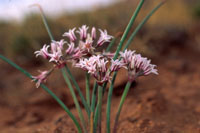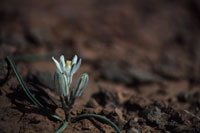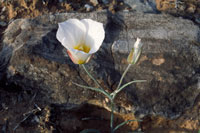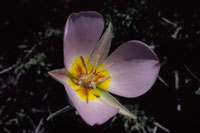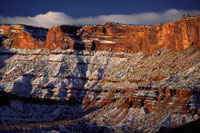Desert lily seems like an oxymoron. Most images of lilies include moist and lush habitats, not parched regions that barely average ten inches of rain per year. Fortunately, there are desert lilies unaware of their tropical relatives.
Beginning in March and proceeding through the summer, there are several desert dwelling members of the Lily Family (Liliaceae) that blossom in Canyon Country. The majority of them grow in grasslands or woodlands, but some prefer the moist conditions of springs and seeps.
Of the desert blooming lilies, the purple funnel lily (Androstephium breviflorum) is one of the first to bloom in the spring. Easily overlooked, the funnel lily barely rises above the ground from a buried inch-wide bulb. This perennial bears one to three grasslike leaves and a leafless flowering stalk with three to eight flowers. The almost one-inch wide flowers are a whitish or dirty green color with a purple or blackish streak down each petal.
The species name breviflorum means “short flower,” indicating the overall size of these plants. The generic name Androstephium is from the Greek words “andros,” meaning “stamen” and “stephanos” meaning “crown.” This refers to the flower’s stamens that are fused together for a majority of their length before they separate, thus resembling, in cross section, a royal crown.
Following the funnel lily in the blooming sequence are the sego lilies (Calochortus nuttallii). Also arising from underground bulbs, the sego lily sends up several grasslike leaves. The generic name Calochortus translates into “beautiful grass,” which refers to the leaves and the beauty of the flowers.
But before mentioning the flowers, the sego lily’s bulbs deserve some aboveground kudos. Native Americans harvested the marble to walnut-sized bulbs for food. During the harsh winter of 1848-1849, Mormon pioneers who had settled in the Salt Lake Valley just a few years prior, faced famine because insects had destroyed their fall crops. The natives showed the newcomers how to harvest and prepare the bulbs, which along with other native roots and tubers staved off starvation. A little more than sixty years later, the Utah State Legislature would decree the sego lily as the State Flower of Utah in 1911.
In addition to the leaves arising from the edible bulbs are the flowering stalks that bear several one to two inch wide, cup-shaped flowers. The large, cream to white colored petals are pointed at the tip. At the base of each petal there is a nectar gland that is surrounded by yellowish hairs and bordered by a purplish crescent. Insects attracted to the flower dives into the bottom to root around for nectar and pollen rewards. While moving about within the flower, these pollinators complete the transaction of pollen to stigma.
The sego lily’s species name honors Thomas Nuttall (1786-1859) an English naturalist who collected plants throughout the West and in Hawaii. He first collected the sego lily in 1811.
Another one of the early season lilies is the prairie wild onion (Allium textile). The three-quarter inch bulb is encased in a loose netlike coating that resembles a woven textile. Another edible bulb, the prairie wild onion has a strong odor and flavor. Unlike the other lilies mentioned, the wild onion produces a bouquet of five to fifty, white to pale pink flowers lined with deep purple nectar guides.
Later on in the season, the alcove death camas (Zigadenus sp.) blooms in moist seeps. The long straplike leaves and flowering stalks bearing numerous flowers. These plants grow in thick bunches in the hanging gardens. Unable to withstand the drier conditions that their desert-dwelling relatives can, this alluring flower arises from toxic bulbs.
After this past wet and snowy winter, the parade of spring flowers might explode into a stellar season. Remember to “take only photographs” and leave the lilies and other flowers behind for the next wildflower enthusiast to enjoy.

